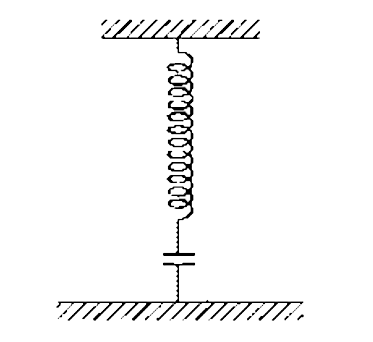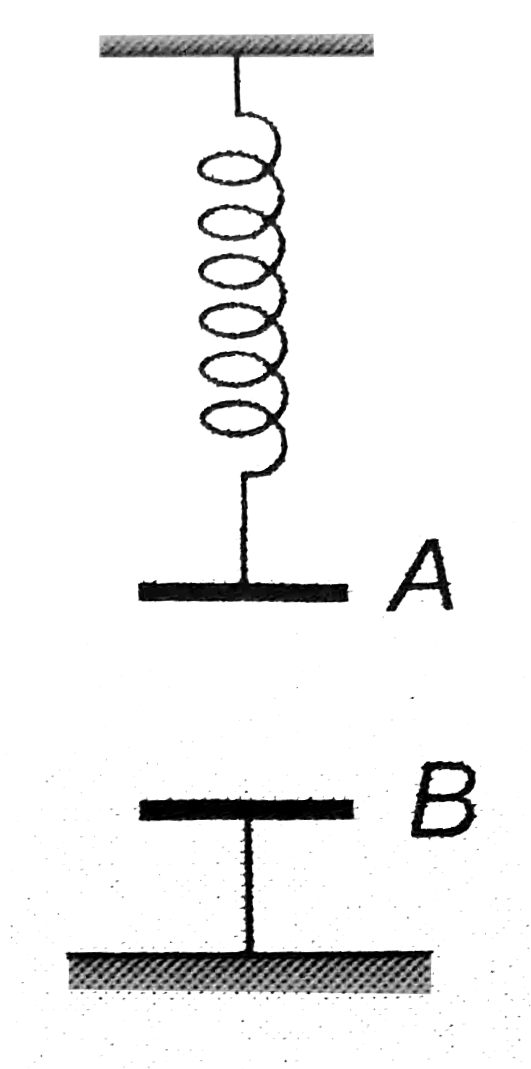A parallel plate capacitor ils arrranged horizontally in a mechanical situation with the lower plate is fixed and the other connected with a perpendicular spring as shown in figure. The area of eachh plate is and in equilibrium the distance between te plates is . WHen the capacitor is connected with a source of voltage , a new equilibrium appears after some displacement in upper plate with the new distasnce between the plates . Given that mass of the upper plate is

Step by step video & image solution for A parallel plate capacitor ils arrranged horizontally in a mechanical situation with the lower plate is fixed and the other connected with a perpendicular spring as shown in figure. The area of eachh plate is A and in equilibrium the distance between te plates is d_(0). WHen the capacitor is connected with a source of voltage V, a new equilibrium appears after some displacement in upper plate with the new distasnce between the plates d_(1). Given that mass of the upper plate is m by Physics experts to help you in doubts & scoring excellent marks in Class 12 exams.
Topper's Solved these Questions
- BOOK - PHYSICS GALAXY - ASHISH ARORACHAPTER - CAPACITANCEEXERCISE - DISCUSSION QUESTIONS22videos
CAPACITANCE
- BOOK - PHYSICS GALAXY - ASHISH ARORACHAPTER - CAPACITANCEEXERCISE - CONCEPTUAL MCQA32videos
CAPACITANCE
- BOOK - PHYSICS GALAXY - ASHISH ARORACHAPTER - ATOMIC PHYSICSEXERCISE - Unsolved Numerical Problems39videos
ATOMIC PHYSICS
- BOOK - PHYSICS GALAXY - ASHISH ARORACHAPTER - CURRENT ELECTRICITYEXERCISE - All Questions389videos
CURRENT ELECTRICITY
Similar Questions
A paallel plate capacitor with air as a dielectric is arranged horizontally. The lower plate is fixed and the other connected with a perpendicular spring. The area of each plate is A and mass of uppar plate is m. In the steady position, the distance between the plates is d0. When the capacitor is connected with a battery of emf V, a new equilibrium appears, with distance between the plate as d.
(a) find the spring constant k.
(b) what is the maximum voltage for a given k in which an equilibrium is possible?
 View Solution
View SolutionWhen a dielectric is introduced between the plates of a capacitor, which is connected to a battery of voltage V, the charge on the plates remains unchanged.
View Solution
Knowledge Check
- Question 1 - Select One
As the distance between the plates of a parallel plate capacitor decreased
Achances of electrical break down will increases if potential difference between the plates is kept constant.Bchance of electrical break down will decreases if potential difference between the plates is kept constant.Cchance of electric break down will increases if charge on the plates is kept constantDchance of electrical break down will decrease if charge on the plate is kept constant. - Question 2 - Select One
When a parallel plate capacitor is connected to a source of constant potential difference
Aall the charge drawn from source is stored in the capacitorBthe potential difference across capacitor grows very rapidly initially and this rate decreases to zero eventuallyConly half of the energy drawn from the source is dissipated outside the capacitorDall of these - Question 3 - Select One
If the distance between the plates of a parallel plate capacitor of capacity of μF is doubled, then new capacity will be
A5μFB2C0 muFD10μF
The distance between the plates of a parallel plate capacitor is 'd'. The capacitance of the capacitor gets doubled when a metal plate of thicknessd2 is placed between the plates.
View SolutionIf the distance between the plates of a parallel plate capacitor of capacity 10μF is doubled, then new capacity will be
View SolutionTwo parallel plate capacitors are filled with dielectrics and connected speparately across same potential difference as shown in figure. Their plate area is A and separation between plates is 'd'. Then the ration of energy stored is:
_2019_CBT7_E01_016_Q01.png) View Solution
View SolutionOne plate of a capacitor is fixed, and the other is connected to a spring as shown in. Area of both the plates is A In strady state (equilibrium), separation between the plates is 0.8d (spring was unstretched , and the distance between the plates was d when capacitor was uncharged). The force conntant of the spring is approximately.
 View Solution
View SolutionA parallel plate capacitor is connected to a battery and inserted a dielectric plate between the place of plates then which quantity increase
View Solution
